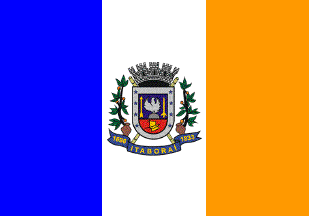 image located by Ivan Sache,
13 March 2012
image located by Ivan Sache,
13 March 2012Source: http://pt.wikipedia.org/wiki/Itabora%C3%AD

Last modified: 2012-03-28 by ian macdonald
Keywords: rio de janeiro | itaboraí |
Links: FOTW homepage |
search |
disclaimer and copyright |
write us |
mirrors
 image located by Ivan Sache,
13 March 2012
image located by Ivan Sache,
13 March 2012
Source:
http://pt.wikipedia.org/wiki/Itabora%C3%AD
Official website at
http://www.itaborai.rj.gov.br/home/index.php.
Dirk Schönberger, 15
October 2011
The municipality of Itaboraí (218,090 inhabitants in 2010; 424 sq. km) is located in the Rio de Janeiro Metropolitan Area, 45 km east of Rio de Janeiro. The municipality is made of the town of Itaboraí proper and of the districts of Porto das Caixas, Itambi, Sambaetiba, Visconde de Itaboraí, Cabuçú, Manilha and Pachecos.
Itaboraí originates in three important "vilas" of the colonial times, Santo Antônio de Sá, São João de Itaborai and São José Del Rey (aka São Barnabé or Itambi). Santo Antônio de Sá was founded in 1697 on the banks of river Macacu. Once a busy center of regional trade inhabited by some 20,000, Santo Antônio de Sá declined because of the proliferation of mosquitos; yellow fever and malaria, locally known as the "Macacu fevers" caused the abandon of the town that was nearly desert in 1830. São João de Itaborai was founded in the 17th century as a stopping point for cow boys and merchants heading to the hinterland; the place was named for "the good stone hidden in the water", that is the fountain around which the settlement developed. A chapel dedicated to St. John the Baptist was consecrated in 1672. Until the 19th century, the main source of income of the region was sugarcane; trade was also active in Porto do Caixas (lit., The Boxes' Port), where good to be shipped to Rio de Janeiro and then exported to Europe were stored in big warehouses. The development of the railway (1874), the epidemics and the abolishment of slavery (1883) caused the decline of Porto do Caixas. In the 1920s, Itaboraí boomed again following the onset of orange tree cultivation. Itaboraí was then the main orange producer in the Rio de Janeiro State and the second in Brazil. In the 1940s, orange production declined, as well as the once famous local pottery. As opposed to orange cultivation, pottery reemerged in the middle of the 20th century. The building of the Rio de Janeiro-Niterói bridge speeded up the urbanization of Itaboraí, which turned into a commuter town in the 1970s. Anarchic urbanization, speculation on land and lack of infrastructure made of Itaboraí one of the poorest municipalities in the Rio de Janeiro State. Itaboraí is the birth town of several people who contributed to the cultural and political development of Brazil, such as the colonial painter José Leandro de Carvalho (1750-1834), who decorated the Royal Chapel in Rio de Janeiro; the actor João Caetano dos Santos (188-1863), who reformed the Brazilian theatre; Joaquim José Rodrigues Torres (1802-1872), Viscount of Itaboraí (1854), who was the first President of the Rio de Janeiro Province (1834-1836), Prime Minister (1852-1853; 1868-1870) of Brazil and, several times, Minister of the Navy, of War and of Economy; the novelist Joaquim Manoel de Macedo (1820-1882), whose most famous works, "A Moreninha" (1844) and "A Luneta Mágica" (1869) are considered as the first urban novel and one of the first fantastic novels, respectively, in Brazilian literature; and the writer and diplomat Salvador de Menezes Drummond Furtado de Medonça (1841-1913), a founding member of the Brazilian Academy of Literature and one of the founders of the Republican Movement.
The flag of Itaboraí is prescribed in "14 units x 20 units", that is, with proportions 7:10. Its use is mandatory in all the official events of the municipality and, in daytime, on the town hall.
The coat of arms of Itaboraí is prescribed by Municipal Law No. 182 of 18 May 1966, modified by Municipal Law No. 1,668 of 30 April 2001. The arms are "Azure an eagle argent surrounded dexter by an arrow or and sinister by a sword of the same, the base gules a parchment or and a quill of the same, a bordure argent charged dexter and sinister with four stars azure. The shield surmounted by a five-towered mural crown argent and placed over two canes proper per saltire. The shield surrounded by two branches of orange tree fructed proper issuing from pottery proper. Below the shield a scroll azure inscribed in letters or '1696 ITABORAÍ 1833' ".
The Portuguese shield recalls the early origin and colonization of Itaboraí. Azure symbolizes zeal, charity and loyalty; gules represents the blood shed by the early pioneers. The eagle represents royalty, representing Itaboraí as a full member of the Rio de Janeiro community. The arrow represents the first inhabitants of the place; Itaboraí means "Good Stone" in native language. The sword is the attribute of St. John the Baptist, the patron saint of Itaboraí. The parchment and quill represents the children of Itaboraí who contributed to the cultural development of Brazil. The eight stars stand for the eight districts forming the municipality. The mural crown stands for a "cidade". The canes represent one of the oldest agricultural resources of Itaboraí. The orange trees recall that oranges were once the main source of income of Itaboraí, then known as "Orange Land". Pottery is the main industry in the municipality. The scroll is charged with the years of establishment of the commune ("1696") and of the municipality ("1833") of Itaboraí. http://www.itaborai.rj.gov.br/home/index.php?pg=historia
Ivan Sache, March 2012